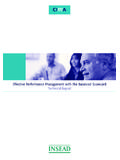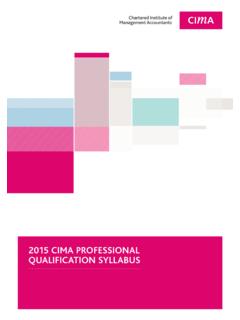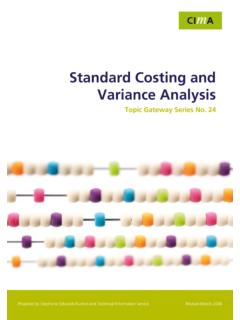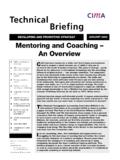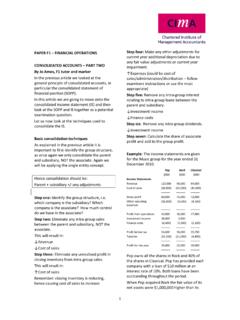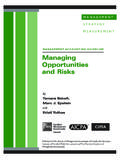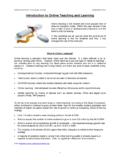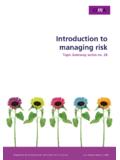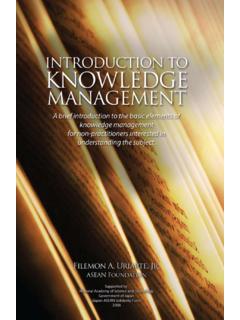Transcription of An Introduction to the PRINCE2 project methodology by …
1 An Introduction to the PRINCE2 project methodology by Ruth Court from FTC Kaplan Of interest to students of Paper P5 Integrated Management. Increasingly, there seems to be a greater recognition of the importance and value of effective project management both as a communication and organisation tool, but organisations are still reluctant to evaluate the reasons why projects fail in their own business and how lessons might be learnt to prevent these problems occurring again in the future. The aim of this article is to present a framework which can be applied within a modern business environment to enhance the chances of success. There are a number of various empirical project methodologies which can be applied these include: PRINCE2 (PRojects IN Controlled Environments PMBOK ( project Management Body of Knowledge).)
2 When studying paper 5 Integrated Management it is not necessary to understand all the of stages of the above methodologies but it would be useful to briefly present the basic principals of the PRINCE method as this is the most commonly applied approach in European industries CIMA 1. April 2006. What is a project methodology ? A project methodology can be thought of in the same terms as a recipe for cooking. It identifies what will be required and how these ingredients will be combined together to produce the perfect meal. In short, a methodology comprises of the following components: Documentation such as project initiation and scoping documents Technique a set of standard project management techniques required to plan and control the project (Critical Path Analysis, Risk Management Procedures etc).
3 Sequence- the order in which the stages will be performed Overview a picture of how the documentation and techniques fit together The application of a structured project methodology during the development and implementation of a new information system helps to impose discipline on the process of the integration of activities within each of the stages which, in turn helps to ensure success. The purpose of the methodology can therefore give the organisation the opportunity to: Divide the project into smaller and easier to manage stages Measure the progress in terms of time, costs and quality Take corrective action if required to bring the project back on track Allocate the resources (human and physical) to the project The above opportunities of the use of the methodology can be directly linked to the reasons why projects fail but, a strong project methodology does not replace the need for good project management skills (just as a cracking recipe does not replace the need for a good cook) but provides a systematic framework into which all of the activities of the project can be placed.
4 PRINCE2 . PRINCE2 is a project management methodology standard in the UK and Europe, and is the required method for all UK government commissioned projects. PRINCE2 is in the public domain and offers best practice guidance on how to manage a project . The diagram below illustrates the structure of the methodology and is principally divided into the following stages: CIMA 2. April 2006. Starting up the project occurs only once and creates and evaluates the business case Directing the project formal organisational structures will be required throughout the life of the project including the project Board and manager, the communication between the stages and the organisation will be continuous Initiating the project this stage will identify how the project will be managed, the project Initiation Document (PID) will form contract and terms of reference for the project as a whole Planning plans relating to project deliverables are continuously produced throughout the lifecycle and of the activity which helps to ensure a consistent approach.
5 Controlling creation of documents which help to manage the day-to-day operations and include change control and quality assurance, this will be an iterative process. Monitoring there is a need to have a feedback process and take action as necessary, authorisation from the project Board is required. Closing the project time is finite and there will need to be a final sign off procedure by the customer that objectives have been satisfied. CIMA 3. April 2006. Corporate and Programme Management project Mandate Directing a project Monitoring Closing a Starting Initiating Controlling Stage project up a a project Stage Boundaries project Managing Product Delivery Planning (Figure PRINCE2 overview). None of the activities identified above have a greater importance than the other but they illustrate how the project can be viewed as a single flow and that relationships can be made between the elements.
6 A number of issues that are addressed with the application Business Case and Stakeholder Analysis Organisation Management of Risk Quality Management Planning Control CIMA 4. April 2006. Business Case and Stakeholder Analysis The importance of the business case cannot be understated, as this is the stage which gives the organisation the opportunity to evaluate the need for the project and determine its anticipated contribution to strategic objectives. The business case will be used to obtain management commitment and approval for investment in business change. The project board (strategic managers who are responsible for the creation of business and corporate strategies) not only develop and put forward the case for the new project but own it.
7 It is this group who assess the desirability of the project and how it can affect business performance. The project manager is responsible for the provision of the information to the project Board to enable them to evaluate the projects in terms of its social, economic, and technical and operational feasibility. To enable the board to make a judgement in strategic terms, it will be necessary for the project manager to present an analysis of the contribution to financial and non-financial objectives to ensure the achievement of political and commercial objectives. Therefore the business case must show: - Business need Customer Clear assurance of realistic and realisable benefits Tangible and intangible costs Planning for the achievement of these objectives is crucial and should not be carried out in isolation therefore there must be process which carefully and systematically evaluate a business context.
8 CIMA 5. April 2006. Organisation Once the business case has been established and the ownership for the deliverables has been identified, there will need to be a formal process of structuring the roles and responsibilities of all of those involved in the project . This will help to enforce the involvement and commitment of senior managers, users, suppliers and IT staff throughout the project . PRINCE2 defines the project Manager as the person given the authority and responsibility to manage the project on a day-to-day basis to deliver the required products within the constraints agreed by the project board, whereas the project Board is the executive. It is important therefore to state the responsibilities for the project as they can be separated into authority (control) and accountability (consequences of success and failure).
9 The Board has the authority and is not held accountable for the success or failure of the project , whereas the project Manager is held accountable but may not have the required authority over project deliverables and resources. PRINCE2 aims to solve this dilemma with the creation of the project Board who is accountable for the project as they own it they are accountable and responsible for the project , this helps to ensure that there is the authority to commit extra resources as and when required. This project board will be able to support the project manager more effectively by being able to react to problems more readily. Management of Risks The success of the project is inherently reliant on the ability of those involved including the Board and project Managers, to use their technical and business knowledge to evaluate and then control the risks.
10 The risks of the project must be evaluated in terms of the consequences of those risks occurring. For example the failure of a key supplier to deliver or the occurrence of uncertain events will negatively impact on the time, costs and quality of the project . If the organisation experiences a problem with a supplier being able to meets it delivery deadlines CIMA 6. April 2006. there may be a need to source a substitute supplier, quality and costs issues may have to be put aside to keep the project on schedule. This can be clearly be illustrated by the Wembley Stadium project where the primary objective is to complete the project in time for the FA. th cup final on 13 May 2006. To enable contractor Multiplex to win the 737 million order they agreed fixed price contractors with all suppliers, when one of their steel suppliers was unable to deliver on time they were forced to enter into a variable price contract with an alternative impacting on the costs of the project and ultimately the organisations profit margins.

